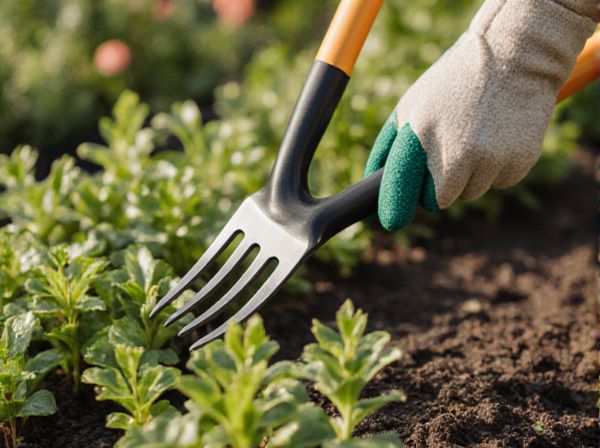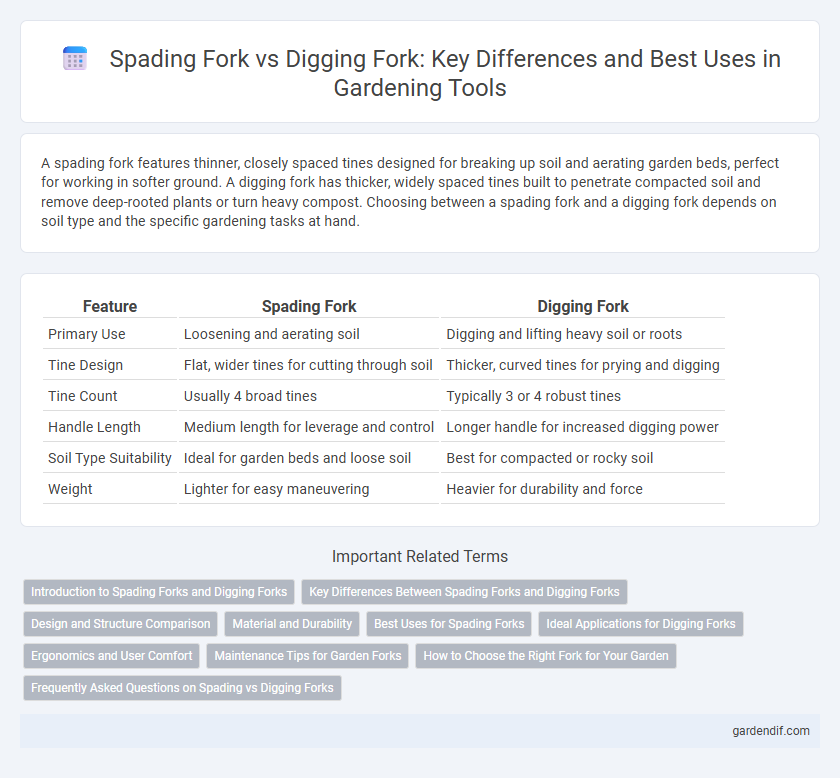
Spading fork vs digging fork Illustration
A spading fork features thinner, closely spaced tines designed for breaking up soil and aerating garden beds, perfect for working in softer ground. A digging fork has thicker, widely spaced tines built to penetrate compacted soil and remove deep-rooted plants or turn heavy compost. Choosing between a spading fork and a digging fork depends on soil type and the specific gardening tasks at hand.
Table of Comparison
| Feature | Spading Fork | Digging Fork |
|---|---|---|
| Primary Use | Loosening and aerating soil | Digging and lifting heavy soil or roots |
| Tine Design | Flat, wider tines for cutting through soil | Thicker, curved tines for prying and digging |
| Tine Count | Usually 4 broad tines | Typically 3 or 4 robust tines |
| Handle Length | Medium length for leverage and control | Longer handle for increased digging power |
| Soil Type Suitability | Ideal for garden beds and loose soil | Best for compacted or rocky soil |
| Weight | Lighter for easy maneuvering | Heavier for durability and force |
Introduction to Spading Forks and Digging Forks
Spading forks feature shorter, thicker tines designed for breaking up compacted soil and aerating garden beds, making them ideal for heavy-duty spading tasks. Digging forks have longer, narrower tines that penetrate deeper into soil, facilitating the loosening and lifting of root crops and heavy clumps. Both tools share sturdy handles for leverage, but spading forks prioritize soil disruption while digging forks excel at extraction and turning.
Key Differences Between Spading Forks and Digging Forks
Spading forks feature shorter, flatter tines designed for breaking up dense soil and cutting through roots, making them ideal for turning heavy earth. Digging forks have longer, more widely spaced tines suited for lifting and aerating soil, as well as extracting vegetables like potatoes without damaging them. The key differences lie in tine length, spacing, and intended application, with spading forks optimized for soil penetration and digging forks for gentle soil manipulation.
Design and Structure Comparison
A spading fork typically features shorter, more robust tines arranged closely together, designed for penetrating compacted soil and breaking up dense earth efficiently. In contrast, a digging fork has longer, straighter tines spaced wider apart, allowing it to lift and aerate soil while minimizing root damage. The handle of a spading fork is often sturdier for heavy leverage, whereas digging forks prioritize ergonomic grip and lighter weight for easier maneuverability during root extraction.
Material and Durability
A spading fork typically features heavy-duty steel tines designed for breaking dense soil and roots, offering superior durability for rigorous garden tasks. Digging forks, often made from tempered steel or stainless steel, prioritize durability while maintaining a lighter weight for easier maneuverability in softer soils. Both tools use corrosion-resistant coatings to extend lifespan, but spading forks generally possess thicker tines for enhanced strength and longevity in tough conditions.
Best Uses for Spading Forks
Spading forks are best used for breaking up heavy, compacted soil and aerating garden beds, making them ideal for preparing ground for planting. Their sturdy, flat tines penetrate dense earth more easily than digging forks, which are better suited for lifting and turning soil or harvesting root vegetables. Gardeners rely on spading forks for tasks requiring soil loosening and aeration without disrupting root systems significantly.
Ideal Applications for Digging Forks
Digging forks excel in breaking up dense, compacted soil and are ideal for transplanting shrubs, aerating garden beds, and turning compost piles. Their strong, widely spaced tines effortlessly penetrate tough ground, making them perfect for tasks requiring deep soil disturbance and root separation. Gardeners and landscapers rely on digging forks for heavy-duty soil cultivation where spading forks might struggle.
Ergonomics and User Comfort
Spading forks feature longer, straighter tines and handles designed for heavy-duty soil turning, providing greater leverage but requiring more physical effort, which may lead to user fatigue. Digging forks have angled tines and ergonomic, cushioned grips shaped to reduce wrist strain, promoting better posture and comfort during prolonged use. Ergonomic handles in digging forks improve user comfort by minimizing repetitive strain injuries, making them preferable for extended gardening tasks.
Maintenance Tips for Garden Forks
Regularly clean garden forks like spading forks and digging forks by removing soil and debris after each use to prevent rust and damage. Sharpen the tines with a metal file to maintain efficiency, and apply a light coat of oil to wooden handles to prevent cracking and extend tool lifespan. Store forks in a dry, sheltered location to avoid moisture exposure and preserve their durability.
How to Choose the Right Fork for Your Garden
Choosing the right fork for your garden depends on soil type and gardening tasks; a spading fork features closely spaced, straight tines ideal for turning heavy, compact soil, while a digging fork has wider, curved tines suited for lifting and breaking up root-bound soil or harvesting root vegetables. Consider the tine material and handle length for durability and ergonomic comfort, ensuring efficient soil penetration and reduced strain during extended use. Selecting between a spading or digging fork optimizes soil aeration and plant health by matching tool design to specific gardening needs.
Frequently Asked Questions on Spading vs Digging Forks
Spading forks feature straight, narrow tines ideal for breaking up compacted soil, while digging forks have broader, curved tines designed for lifting and turning heavier materials like root vegetables or dense soil. Gardeners often ask if spading forks can replace digging forks in harvesting tasks, but their slender design makes them better suited for soil aeration than heavy lifting. Choosing between spading and digging forks depends on soil type and gardening needs, with spading forks providing precision and digging forks offering strength and leverage.
Spading fork vs digging fork Infographic

 gardendif.com
gardendif.com